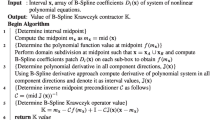Abstract
Multitone Harmonic Balance (HB) is widely used for the simulation of the quasiperiodic steady state of RF circuits. HB is based on a Fourier expansion of the unknown waveforms and is state-of-the-art. Unfortunately, trigonometric polynomials exhibit poor convergence properties in cases where the signal is not quasi-sinusoidal which leads to a prohibitive run-time even for small circuits. Moreover, the approximation of sharp transients leads to the well-known Gibbs phenomenon, which cannot be reduced by an increase of Fourier coefficients. In this paper, we present an alternative approach based on alternatively cubic or exponential splines for a (quasi-) periodic steady state analysis. Unlike trigonometric basis function, a spline basis solves for a variational problem, i.e., the cubic spline minimizes the curvature. Because of their compact support, spline bases are better suited for waveforms with sharp transients. Furthermore, we show that the amount of work for coding of splines is negligible if an implementation of HB is available. In general, designers are mainly interested in spectra and not in waveforms. Therefore, a method for calculating the spectrum from a spline basis is derived too.
Similar content being viewed by others
References
Brachtendorf HG (1994) Simulation des eingeschwungenen Verhaltens elektronischer Schaltungen. Shaker, Aachen
Brachtendorf HG (1997) On the relation of certain classes of ordinary differential algebraic equations with partial differential algebraic equations. Technical Report 1131G0-791114-19TM, Bell-Laboratories
Brachtendorf HG, Laur R (2000) Multi-rate PDE methods for high Q oscillators. In: Mastorakis N (ed) Problems in modern applied mathematics. World Scientific, Athen, pp 391–298, July 2000. CSCC 2000, MCP 2000, MCME 2000 Multi-conference
Brachtendorf HG, Welsch G, Laur R, Bunse-Gerstner A (1996) Numerical steady state analysis of electronic circuits driven by multi-tone signals. Electron Eng 79(2): 103–112
Pulch R (2003) Finite difference methods for multi time scale differential algebraic equations. Z Angew Math Mech 83(9): 571–583
Roychowdhury J (1997) Efficient methods for simulating highly nonlinear multi-rate circuits. In: Proc. IEEE Design Automation Conf., pp 269–274
Roychowdhury J (2001) Analyzing circuits with widely separated time scales using numerical PDE methods. IEEE Trans Circuits Syst I Fundam Theory Appl 48: 578–594
Ting Mei, Roychowdhury J, Coffey TS, Hutchinson SA, Day DM (2005) Robust, stable time-domain methods for solving MPDEs of fast/slow systems. Comput Aided Des Integr Circuits Syst IEEE Trans 24(2): 226–239
Pulch R, Günther M (2002) A method of characteristics for solving multirate partial differential equations in radio frequency application. Appl Numer Math 42: 399–409
Constantinescu F, Nitescu M, Enache F (2004) 2D time domain analysis of nonlinear circuits using pseudo-envelope initialization. In: Proceedings of the 2nd international conference on circuits and systems for communication, Moscow
Constantinescu F, Nitescu M (1999) A multi-rate method for finding the periodic steady-state of nonlinear high-speed circuits. In: Proceedings of ECCTD’ 99, pp 767–770
Dautbegovic E, Condon M, Brennan C (2005) An efficient nonlinear circuit simulation technique. IEEE Trans MTT 53(2): 548–555
Kundert KS, White JK, Sangiovanni-Vincentelli A (1990) Steady-state methods for simulating analog and microwave circuits. Kluwer Academic, Boston
Rösch M, Antreich K (1992) Schnelle stationäre Simulation nichtlinearer Schaltungen im Frequenzbereich. AEÜ 46(3): 168–176
Stoer J, Bulirsch R (1990) Numerische Mathematik 2. Springer, Berlin
Deuflhard P, Hohmann A (1993) Numerische Mathematik I - Eine algorithmisch orientierte Einführung. de Gruyter
Author information
Authors and Affiliations
Corresponding author
Additional information
This paper is dedicated to Prof. Dr.-Ing. Rainer Laur, University of Bremen, on the occasion of his 65th birthday. This work has been partly supported by the ICESTARS project of the European Community under grant 214911.
Rights and permissions
About this article
Cite this article
Brachtendorf, H.G., Bunse-Gerstner, A., Lang, B. et al. Steady state analysis of electronic circuits by cubic and exponential splines. Electr Eng 91, 287–299 (2009). https://doi.org/10.1007/s00202-009-0137-7
Received:
Accepted:
Published:
Issue Date:
DOI: https://doi.org/10.1007/s00202-009-0137-7



